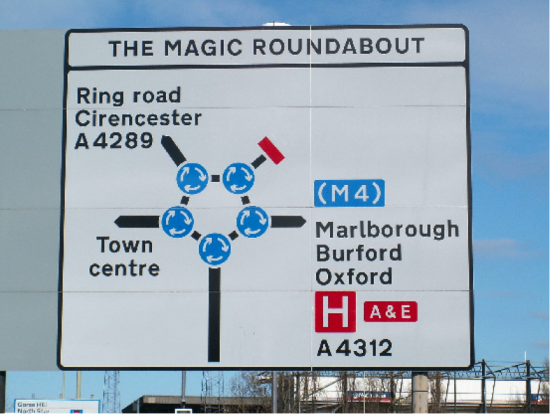At the start of the century, Gary Stock coined the term “Googlewhack”, meaning you could type two words into the 4-year-old Google and it would return one single search result.
Developing a UX Team that really works is so important and so hard to navigate, and yet Googling “UX team” returns next to nothing. So I’m picking up where Google has dropped the ball to bring together 5 roads to unity and success for anyone who works in, or leads, a UX team.

The 5-way “Magic roundabout” in Swindon, UK. Hard to navigate, easy to Google.
1. Become Principled
First things first:
Without unity,
creative people pull in different directions,
which breeds conflict and spawns inconsistency,
which leads to a poor customer experience,
which is the beginning of the end.
Developing shared design principles is key to uniting the team on the same journey and designing a unified product.
Take Japanese brand Muji. Every store and product has an unparalleled sense of well-understood meaning and coherent simplicity. As designers, we know that simple is hard. We understand the level of thought and design that goes into crafting such apparent simplicity. The Japanese call this concept of simple design, “Shibumi”.
How do you get a set of principles suited to your product and your team?
Well, most great things are achieved by standing on the shoulders of giants. The design principles of Google, Dieter Rams and over 60 more, (including Muji), are in the excellent collection by Gabriel Svennerberg (@svennerberg). Drafting your own set of principles might go something like this:
- Get everyone in your team to pick their favourite set of principles.
- Pick a few principles each that really resonate.
- Collaboratively refine them down to a set that suits your needs.
- Create a poster, stick it on every desk and design together as one.
2. Co-locate
OK, so we're talking about uniting a UX team by splitting them up? It may seem counter-intuitive, but under pressure, centralised teams tend towards a tribal “us and them” atmosphere where “the rest of the business doesn't get it”. Agile, co-located teams are the best way of disseminating the work of a few good people to the many in the wider business.
UXers that are co-located with project teams naturally become more balanced and less “UXtremist” (See this article on finding balance in teams). This reduces conflict. There's a saying I try to remember (hard at times) that as emotion increases, intelligence decreases. So how do you divide and conquer, yet still be UX united? Well that brings me to my next point.
3. Share key rituals
If your team currently sit together, how much of the daily dialog is actually solid collaboration? Not much, as you're all working on different things, right? Once co-located you need a regular cadence of sharing, design collaboration and bonding rituals.
- Incept together. The 6-up design studio method is awesome for team bonding. Including the team in initial sketch sessions helps with divergent thinking, but it also creates a shared understanding of underlying design challenges. A team that shares understanding of a problem can help one another.
- Deep-dive together. Come together to review, critique, get input and share regularly. I'll not try to cover it here but you'll need to create a shared understanding of how to critique for good and not tear down each other’s work. The first rule of this is “it's not about you”, either as designer or reviewer.
- Share a home. Although you're co-located you're going to need a place to call home and to retreat to when the team needs to smash something out together, or if you need isolation to think something through. This is why you need a design war-room. Decorating your home with sketches, research insights, visual designs, customer journeys and the like helps provide inspiration and assists with consistency across the team.
- Eat pork together. Perhaps not literally, but it’s good to do stuff other than design together. When you look at plane crashes, a common cause is that the pilot and co-pilot never flew together:
“In a review of major accidents from 1978 to 1990, the National Transportation Safety Board (1994) found that 73% of commercial aviation accidents occur on the first day of a crew pairing.” http://lunatractor.com/2013/01/09/communicate-or-crash/
They didn’t understand each other. Recently I worked in a great team located in a cultural and culinary abyss in the otherwise amazing city of Melbourne. A local cafe served roast pork on Thursdays and like egg-laden turtles under a full-moon, nature bought the UX team together, to eat pork and chew the fat. It didn't need to be organised formally, it just happened. Relationships & understanding grew. So did collaboration, consistency and design maturity.
4. From opinion to data-informed design
This old chestnut. We're all passionate about design and everyone in the organisation thinks they can design. More often than not the thought process goes, “I think this, she thinks that and the stakeholder thinks the other.” Someone, presumably well-intentioned, attempts to break the impasse with “what do our customers think?” and due to time pressures everyone agrees that “we don't have time to find out”.
Familiar huh?
Large-scale strategic customer research takes time. It needs to be planned in advance and tends towards the big questions. Lean UX (read Jeff Gothelf’s must-read book) and tactical guerilla testing look after the masses of smaller questions. In a prior team we ran a program called “Dialogue” which bought in customers to knock on our door regularly, on the assumption that we’d have questions for them. Working part-time, 2 days a week, I used 1 week to plan, 1 week to test and 1 week to learn and pivot. That’s just 6 days per cycle for valuable dialogue. If you don’t have questions for customers every few weeks, you’re doing it wrong.
Yet don’t fall into the analysis-paralysis trap that every question has to be answered first-hand. Your project needs to deliver. Consider a Design Principal to arbitrate between the merits of line-ball options. As stakeholders have seen the benefits of data to inform decisions it seems to have somehow become “data vs intuition”, but there’s a place for both, its data AND intuition. A place for intuition remains in design and the right principal will have gathered behavioural insights from literally hundreds of hours of observing users.
Data is always evolving. This can, and must, guide decisions where current first-hand research is not available. Remember in most cases you can still gradually release it to customers, learn from analytics and pivot.
5. Get your s*it together.
You’re going to need a research library. If someone can’t find research it doesn’t exist so I favour a timeline across a corridor wall. Every time research is done it gets summarised as a one-pager and put on the wall as the start of the conversation and a pointer to the detail. Get metrics and benchmarks if you can so you can see improvement as you walk the wall.
You’re also going to need a pattern library. We’re currently using patternry.com but the take-up matters far more than the tool. The first step is to go wide and carpet-bomb the library with as many patterns, screen-shots and sketches as you can find across the organisation. Here begins the discussion, refinement and evolution. If it’s shared and it’s good it will be re-used. If it’s shared and it’s not good then at least the team has a vehicle to understand why. Sure it might be a painful discussion, but the finest steel has to go through the hottest fire. Patterns need to be consistently good, consistently evolving and it’s important to remember that they can be consistent without being uniform, with a common core and refinement to suit their context (user segment, device, project requirements etc.).
If you’re going to push forward you need a firm foundation. You’ll want a style guide as well as a few other basics. As with anything, doing ordinary things extraordinarily well makes a real difference.
So there you go. Enjoy Christmas, reflect and kick into the New Year ready to make your team awesome.
Over many years, many great people have put ideas in my head that contributed to this article. In particular I'd like to mention @cameron_rogers, @dipants, @chris_khalil and will prepare myself for the barrage from others that I didn't mention but should have.

